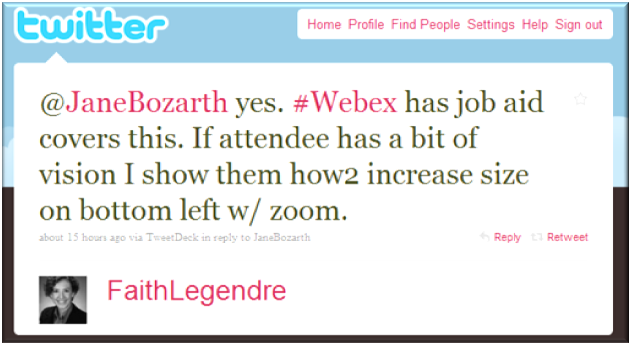Since Social Media for Trainers was published I’ve fielded lots of questions about incorporating social media tools into workplace learning endeavors. Another question that comes up relates to the developmental needs of trainers and instructional designers: What are some strategies for building or extending your own Personal Learning Network (PLN) via social media tools? Here are a few ideas.
Who? Find the people you want to know.
My interests are in e-Learning, instructional design, social learning, and social media. In my work setting, there is no one else who does what I do. It’s great if you can structure your own PLN on a local scaffold, but I have no such luxury. I tried a number of social media sites and found that, in general, for me, most of the conversations I wanted to be part of were happening on Twitter. Searching terms like “e Learning” “instructional design” “ID” “social media” and “social learning” led me to interesting voices to follow. Some people share what they’re reading, like interesting articles or blog posts. Others prompt, provoke, and encourage new thinking. The best do both and the ones I choose to follow not only broadcast but also engage. You can also try searching blogs and browsing around Facebook and LinkedIn groups to see who’s talking about what.
Where? Find the conversations.
My best time investment all week is the Twitter-based #lrnchat, which happens twice each Thursday (11:30 am ET with questions repeated at 8:30 pm ET). See http://lrnchat.wordpress.com/ for more information on #lrnchat; see the “Twitter chats” list for spreadsheet listing hundreds of chats: https://spreadsheets.google.com/ccc?key=0AhisaMy5TGiwcnVhejNHWnZlT3NvWFVPT3Q4NkIzQVE&hl=en#gid=0). LinkedIn has dozens of groups for L&D professionals, many with hundreds of members who have raucous conversations that often go on for days. Facebook likewise has a number of groups and pages worth exploring. Again, look at the individuals who participate there: Who says things that align with your own thinking? Who makes you think new things? Who seems to always have something new to say? Who only repeats what’s already been said?
What else? Expand your surface area.
Brown, Davison, & Hegel’s Power of Pull stresses the importance of reaching outside your usual areas of interest and expertise. This stretches you and helps you avoid the insularity that can come from too much time spent in your own box with only those who share your own particular interests. Reading in areas like cultural anthropology, social anthropology, and social psychology helps me participate in other conversations related to social learning. I’m not a Foursquare player, but I learned a great deal about location-based learning from popping in on #4SqChat one evening, and made some connections that have lasted.
The value of the PLN?
It’s primarily about learning. I have
found many like-minded connections, yes, but I also have found some
who really challenge my thinking. In an age with so much information,
I find that my PLN is wonderful in helping me filter important
content and directing me toward good new books, blogs, and other
resources. I’ve learned a great deal about what other folks do all
day, what other jobs entail, and what challenges others face in their
roles. I find that often now my PLN is my go-to ahead of Google.
(Google’s great if you know what you’re looking for, but that’s
not always the case.) Example: One afternoon I got a call from our
Vocational Rehab division with a question about how to accommodate a
Webinar attendee with a visual impairment. Now, I’ve been doing
virtual classroom training for 7 years, but hadn’t run into this
issue and didn’t know anyone in my work world to ask. I could’ve
spent the afternoon Googling or trying to find someone local who
knew. Instead, I turned to my PLN and tweeted (Figure 1):

Figure 1: Tweet to PLN asking for help.
Within 90 seconds I had several answers, including this one (Figure 2):

Figure 2. Response from PLN within 90 seconds. Screenshot used with permission of Faith Legendre.
I was able to go straight to this document, it had the answer I needed, and I went back to work.
How? It’s about social, not just media.
Simply showing up is not enough. As with most things in life, you get back what you put in. If you want to build a Personal Learning Network, then you must be an active part of that network; it’s not a spectator sport. Early on just try sharing some links, articles, or blog posts. Comment on blogs and Facebook pages updates. Participate in LinkedIn discussions. Don’t just lurk in #lrnchat but throw something out there. The response I got in the example above happened not because I tweeted a question out to the world, but because I am an active participant in my PLN. I tweet a lot, I share articles and information, I am active in many conversations, and I try to make some real connections from time to time. If you engage, people will engage back. So the real key to building a strong PLN? Show up. Share. And participate.



